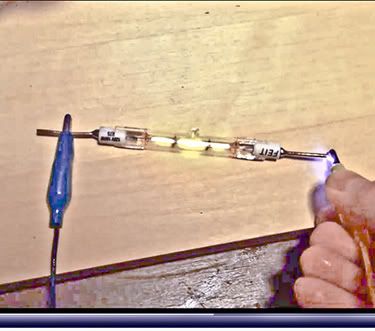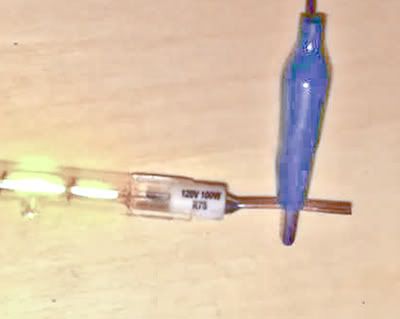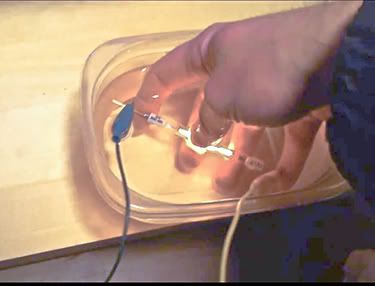Real0ne
Posts: 21189
Joined: 10/25/2004
Status: offline

|
quote:
ORIGINAL: Real0ne
quote:
ORIGINAL: Politesub53
quote:
I showed that it is qa 110 volt 100 watt bulb and I showed you the 1/8th inch ++ arc too and the video.
HERE IS THE 1/8TH INCH ARC:

here is the rating;

Its even safe underwater;

here he holds it in his fingers and no shock
Light, The Tesla Way-01 - TMT 72.4 Scale
BUT I DONT GET A SHOCK EXPLAIN WHY Mr WIZARD?

there is no shock ZIPPO NADA when lighting a 110 volt 100 watt bulb and touching the electrodes?
More electromagnetic non mechanical voodoo maybe huh?
My qualifications to answer this come from 40 years of working on live electrical equipment , most of it either 415v 240v or 110v.
In the pictures you posted the guy is never the least past of resistence. If you look at the photo, the lamp is always connected to the wires, so the voltage takes the easiest path, which is down the copper.
It is also possible to touch a live terminal provided you are sufficiently earthed, although the higher the voltage the riskier this is. If you are working on a wooden ladder, ot standing on an insulated block (dry wood, rubber mat) you wont get a shock UNLESS you touch both live and earth/neutral terminal at the same time.
For the fingers across the halogen bulb it is taking the easiest path, that is true, however its the current not the voltage. Voltage is only the potential or pressure as the old timers put it.

now in the video however you can see it dim considerably when he grabs it which goes without saying that he also is acting as the circuit but gets no shock.
Next you would not dare stick your hands in water like he did with convention ac power because you will get zaped.
Next there is that really nagging problem in the hairpin that it is shorted and the light bulbs are connected across a dead short and they light.
I reposted th epics so you can see the top one he is holding an 1/8th inch arc to the right terminal of the bulb.
The print does not show the voltage but that is a furnace transformer running between 10 - 15,000 volts into the hairpin.
Sort of throws a wrench into conventional electricity taught in school and it works and frankly works very well and consumes from "their" tests considerably less energy to light the same bulb. Tesla of course was known for being a perfectionist and perfecting everything he did so no one else could do an end=run around his patents lol
people sometimes accuse me of setting them up to fail and I have no reason to do that, they set themselves up for me.
quote:
ORIGINAL: Politesub53
quote:
How about you ana ax whatever explain why there is not shock ZIPPO NADA when lighting a 110 volt 100 watt bulb and touching the electrodes?
More electromagnetic non mechanical voodoo maybe huh?
My qualifications to answer this come from 40 years of working on live electrical equipment , most of it either 415v 240v or 110v.
you BRAG about your qualifications, which only proves that you are clueless about the topic and know next to nothing about electricity.
Just because you are a lineman notwithstanding.
I showed you the schematic and gave you a full description and CHILDREN for fuck sake are building these devices in their mommy and daddies basements and you cant even respond with anything beyond DUH proving the vacancy in our schools and work places of today. thank you very much.
oh and BTW, B2 is a shorting bar on the schematic, I presume you cant read that either, and the resistance that I gave ron the answer for is voltage squared divided by the power in this case the operating wattage. it is NOT a short as he claimed. The question is do you know how to use a calculator for sinmple division?
< Message edited by Real0ne -- 8/12/2012 12:03:24 PM >
_____________________________
"We the Borg" of the us imperialists....resistance is futile
Democracy; The 'People' voted on 'which' amendment?
Yesterdays tinfoil is today's reality!
"No man's life, liberty, or property is safe while the legislature is in session
|






 Profile
Profile

 yawn
yawn 




 New Messages
New Messages No New Messages
No New Messages Hot Topic w/ New Messages
Hot Topic w/ New Messages Hot Topic w/o New Messages
Hot Topic w/o New Messages Locked w/ New Messages
Locked w/ New Messages Locked w/o New Messages
Locked w/o New Messages Post New Thread
Post New Thread